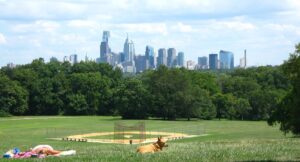In the previous article “Fair Control,” I introduced the concept of enacting Fare control on Regional Rail/Septa. How exactly would that work?
Abstract: All regional rail stations within a designated urban movement area (aka Metro Zone) are to be made compatible with the fare control procedures on the subway.
Method:
- Regional Rail stations within the designated urban movement zone will be retrofitted with turn styles made to accept tokens and fare cards.
- Customers will be able to enter all stations within the Metro Zone by using a token. Tickets will be checked upon departure outbound from the Metro limit. Outbound fares will be adjusted accordingly, as travelers from the city to the suburbs will have already paid a token to enter the system.
- Inbound fares will include the value of a token.
Announcements will be made on the trains prior to reaching a station at the limit of the Metro Zone, informing customers that they must depart here if they do not possess a ticket, or means to pay the additional fare. When the train stops, the announcement is repeated, and platform times are doubled at such metro limit stations. Conductors clear the platform and shout all aboard prior to departure when outbound.
To meet the minimum frequency requirements of the Metro Zone, to make these lines reliable for non regimented travel, some trains will simply reverse direction when reaching the metro limit, rather than continuing on their suburban service. System wide improvements in automation, and if appropriate, a reduction in the number of cars per train will be necessary to reduce headway on all legacy services.
Any Metro stations outside the metro zone will require the payment of additional fare to enter the station, or when exiting, for outbound trips. In the current plan revision, the only such stations are Manayunk, and those along a remote section of Roosevelt Boulevard.
Ultimately, it may be beneficial to include the entire regional rail network in the fare control system, to reduce personnel costs associated with collecting tickets. It remains to be determined however, exactly how much regional rail customers ought to pay for their commutes. On one hand, those living outside the city limits should be required to pay in user fees what they don’t contribute in taxes. On the other hand, to reduce car traffic in the city, costs should remain as competitive as possible. The spend-cap system described in the previous article is a critical component in this strategy, as the psychological consideration of ridership is shifted from a cost-per-trip mentality to one of increased-value-per-use.
The other avenue to consider, is incentivizing suburban vehicle owners not to drive into the city with them by way of reciprocal tax agreements with outlying municipalities, or more simply, by creating disincentives in the form of reduced vehicular access (center city car free zone,) and/or increased costs. The price of parking at the new inter-modal centers will influence this, and additional tolling at city portals and crucial points of congestion should be considered.
Of course, suburbanites will always want, and need, to own cars. The objective is not to discourage vehicle ownership, but to make ridership more attractive to those that are going to invest in a personal vehicle regardless.

 Philadelphia lays claim to what is oft boasted the largest urban park in the world, or the largest landscaped park in the world. These claims of course allude to Fairmount park, or the conglomerate Fairmount park system. Fewer claims however, have been that Fairmount Park is the best park in the world. In this series, we will explore Fairmount’s assets and design, its historical intentions and its current state of disrepair. Through these lenses will come a series of proposals by which Fairmount may yet become the world’s finest urban park.
Philadelphia lays claim to what is oft boasted the largest urban park in the world, or the largest landscaped park in the world. These claims of course allude to Fairmount park, or the conglomerate Fairmount park system. Fewer claims however, have been that Fairmount Park is the best park in the world. In this series, we will explore Fairmount’s assets and design, its historical intentions and its current state of disrepair. Through these lenses will come a series of proposals by which Fairmount may yet become the world’s finest urban park.
